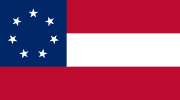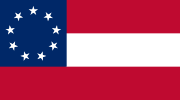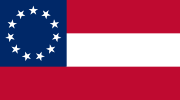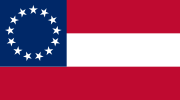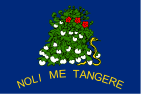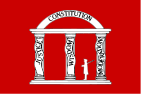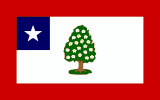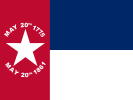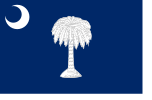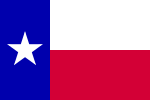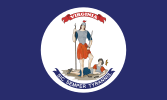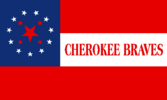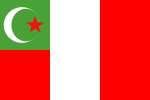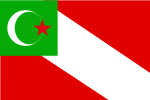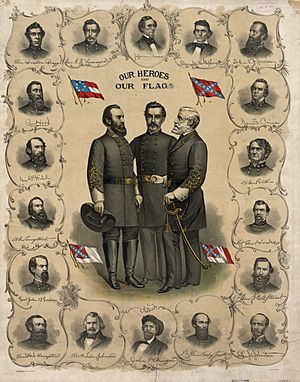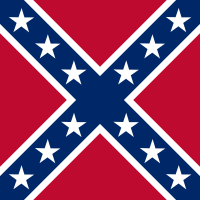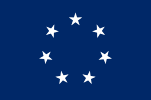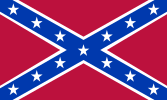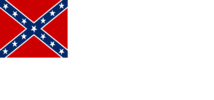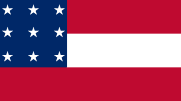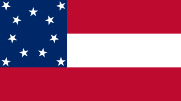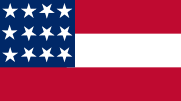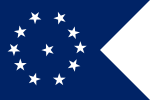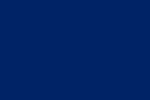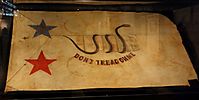Flags of the Confederate States of America facts for kids
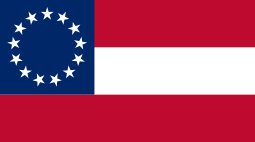
Variant of the first national flag with 13 stars
(November 28, 1861 – May 1, 1863) |
|
| Name | "The Stars and Bars" |
|---|---|
| Use | National flag |
| Proportion | 5:9 |
| Adopted | March 4, 1861 (first 7-star version) November 28, 1861 (final 13-star version) |
| Design | Three horizontal stripes of equal height, alternating red and white, with a blue square two-thirds the height of the flag as the canton. Inside the canton are seven to thirteen white five-pointed stars of equal size, arranged in a circle and pointing outward. |
| Designed by | Nicola Marschall |
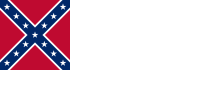
The second national flag of the Confederate States of America
|
|
| Name | "The Stainless Banner" |
| Use | National flag |
| Proportion | 1:2 |
| Adopted | May 1, 1863 |
| Design | A white rectangle two times as wide as it is tall, a red quadrilateral in the canton, inside the canton is a blue saltire with white outlining, with thirteen white five-pointed stars of equal size inside the saltire. |

The third national flag of the Confederate States of America.
|
|
| Name | "The Blood-Stained Banner" |
| Use | National flag |
| Proportion | 2:3 |
| Adopted | March 4, 1865 |
| Design | A white rectangle, one-and-a-half times as wide as it is tall, a red vertical stripe on the far right of the rectangle, a red quadrilateral in the canton, inside the canton is a blue saltire with white outlining, with thirteen white five-pointed stars of equal size inside the saltire. |
| Designed by | Maj. Arthur L. Rogers |
The flags of the Confederate States of America were the official flags used by the Confederacy during the American Civil War. There were three main designs used from 1861 to 1865. These flags were known by different nicknames: the "Stars and Bars," the "Stainless Banner," and the "Blood-Stained Banner."
Even though it was never an official national flag, a special "battle flag" design became very popular. This design was later included in the second and third national flags. Today, this battle flag is the most recognized symbol of the Confederacy. After the Civil War, people continued to use Confederate flags, especially the battle flag. This has led to many discussions and disagreements in the United States about what these flags represent.
Contents
- The First Flag: "Stars and Bars" (1861–1863)
- The Second Flag: "Stainless Banner" (1863–1865)
- The Third Flag: "Blood-Stained Banner" (1865)
- State Flags of the Confederacy
- Indian Territory Flags
- The Confederate Battle Flag
- Naval Flags of the Confederacy
- Other Confederate Flag Designs
- Images for kids
- See also
The First Flag: "Stars and Bars" (1861–1863)
The first official flag of the Confederacy was called the Stars and Bars. It was used from March 4, 1861, to May 1, 1863. An artist named Nicola Marschall designed it. The flag looked a bit like the Flag of Austria, which Marschall probably knew.
The first version of the "Stars and Bars" had a circle of seven white stars on a blue square. These seven stars stood for the first seven states that joined the Confederacy: South Carolina, Mississippi, Florida, Alabama, Georgia, Louisiana, and Texas.
Why the First Flag Was Chosen
The Confederate Congress formed a group called the Committee on the Flag and Seal. This committee asked people to send in their ideas for a new flag. Many people wanted a flag that looked similar to the U.S. flag.
William Porcher Miles, who led the committee, had designed a different flag that later became the Confederate Battle Flag. He liked his design better. However, because many people wanted a flag similar to the U.S. flag, the "Stars and Bars" design was chosen.
Changes to the "Stars and Bars"
As more states joined the Confederacy, more stars were added to the flag. Eventually, the flag had 13 stars. These stars represented states like Virginia, Arkansas, Tennessee, North Carolina, and even Missouri and Kentucky. The last two states didn't officially leave the Union, but some groups there supported the Confederacy.
Problems with the First Flag
The "Stars and Bars" flag caused problems during battles, like the First Battle of Bull Run. It looked too much like the Union (U.S.) flag, especially when it was hard to see. This made it difficult for soldiers to tell friends from enemies.
Many Confederates also disliked the "Stars and Bars" for another reason. They felt it looked too much like the U.S. flag, which they were fighting against. Some called it a "copy" of the U.S. flag. They wanted a flag that was completely different and showed their new identity.
The Second Flag: "Stainless Banner" (1863–1865)
 |
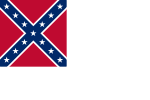 |
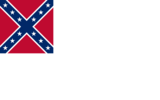 |
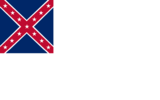 |
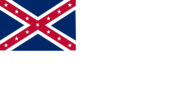 |
| Second national flag (May 1, 1863 – March 4, 1865), 2:1 ratio | Second national flag (May 1, 1863 – March 4, 1865), also used as the Confederate navy's ensign, 3:2 ratio | A 12-star variant of the Stainless Banner produced in Mobile, Alabama | Variant captured following the Battle of Painesville, 1865 | Garrison Flag of Fort Fisher, the "Southern Gibraltar" |
Because of the confusion and dislike for the "Stars and Bars," the Confederacy decided to create a new national flag. Many new designs were suggested. Most of these new ideas were based on the popular Battle Flag.
By 1863, the Battle Flag was very well-known and liked throughout the Confederacy. The new flag was designed to have a white background with the Battle Flag in the top left corner. This new flag was officially adopted on May 1, 1863.
The Meaning of the "Stainless Banner"
This flag is also known as the Stainless Banner. The white part of the flag was meant to represent "purity, truth, and freedom." Some people, like newspaper editor William Tappan Thompson, also saw the white as a symbol of the idea that white people were superior.
General P. G. T. Beauregard also suggested a similar design. He wanted the battle flag to be in the corner, with the rest of the flag being all white or all blue. The final design ended up being mostly white.
Issues with the Second Flag
At first, people liked the "Stainless Banner." But soon, some started to say it was "too white." Military officers especially complained. They worried it could be mistaken for a flag of truce, which means a sign of surrender. This was a big problem, especially for naval ships.
Because of this, some Confederate soldiers even cut off the white part of the flag, leaving only the battle flag section.
The first time the "Stainless Banner" was officially used was to cover the coffin of General Thomas J. "Stonewall" Jackson when he passed away on May 12, 1863. Because of this, the flag was sometimes called the "Jackson Flag."
The Third Flag: "Blood-Stained Banner" (1865)
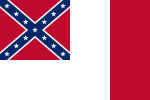 |
 |
| Third national flag (after March 4, 1865) | Third national flag as commonly manufactured, with a square canton |
To fix the problems with the "Stainless Banner," a third national flag was adopted on March 4, 1865. This flag added a wide red stripe to the right side of the white field. This new design was nicknamed the "Blood-Stained Banner."
Major Arthur L. Rogers helped make this change happen. He said the new design, with its red stripe and the saltire (X-shape) from the Scottish flag, showed where the Confederate people came from. He also wanted "as little as possible of the Yankee blue," because the Union Army wore blue uniforms.
Because this flag was adopted very late in the war, just before the Confederacy ended, very few of these flags were actually made or used in battle. Many Confederate soldiers never even saw this flag.
State Flags of the Confederacy
-
Flag of Alabama (front side)
(January 11, 1861) -
Flag of Arkansas
No flag -
Flag of Florida
(September 13, 1861) -
Flag of Georgia
(unofficial) -
Flag of Louisiana
(February 11, 1861) -
Flag of Mississippi
(March 30, 1861) -
Flag of North Carolina
(June 22, 1861) -
Flag of South Carolina
(January 26, 1861) -
Flag of Tennessee
(unofficial) -
Flag of Texas
(January 25, 1839) -
Flag of Virginia
(April 30, 1861)
Besides the national flags, many individual states that joined the Confederacy also had their own state flags during the Civil War. These flags often showed symbols important to each state.
Indian Territory Flags
-
Flag of the Choctaw Brigade (modern-day Oklahoma)
(adopted in 1860) -
Flag of the Muscogee (Creek) Nation
Some Native American nations, located in what was then called Indian Territory (now Oklahoma), also had their own flags while allied with the Confederacy. These flags represented their unique groups.
The Confederate Battle Flag
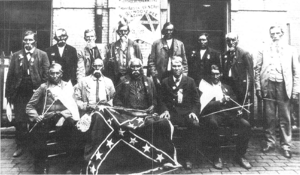
At the first major battle of the Civil War, the First Battle of Bull Run, there was a lot of confusion. The "Stars and Bars" flag looked too much like the U.S. flag. This made it hard for commanders to tell which side was which.
After this battle, General P. G. T. Beauregard decided that his troops needed a special "Battle flag." This flag would be very different from any other flag. He asked William Porcher Miles for help, who had already designed a flag that was not chosen as the national flag.
Design of the Battle Flag
Miles's design for the battle flag was inspired by flags used in South Carolina when it decided to leave the Union. His original design had a blue upright cross on a red field. However, to avoid any religious symbols, he changed the cross to a diagonal "X" shape, called a saltire.
The number of stars on the battle flag changed over time. It started with 12 stars, representing the states that had joined the Confederacy. Later, it had 13 stars to include Kentucky and Missouri.
General Joseph E. Johnston suggested making the flag square to save fabric. Generals Beauregard and Johnston approved the 12-star battle flag design in September 1861.
The Battle Flag in Use
On November 28, 1861, soldiers in General Robert E. Lee's Army of Northern Virginia received these new battle flags. They carried them throughout the Civil War. The soldiers felt proud of these "fighting colors," and it helped boost their spirits after the confusion of earlier battles.
Over time, the battle flag became strongly linked with the Confederacy and the Southern states. After the war, groups of Confederate veterans, like the United Confederate Veterans, adopted this flag as their symbol. This helped make it known as "the soldier's flag" or "the Confederate battle flag."
The Confederate States Navy used several different flags on its ships. These included jacks (flags flown at the front of the ship when anchored), battle ensigns (flags flown at the back of the ship during battle), and other special flags.
-
The Second Navy Ensign of the ironclad CSS Atlanta
-
The 11-star Ensign of the Confederate Privateer Jefferson Davis
-
Pennant of Admiral Franklin Buchanan, CSS Tennessee, at Battle of Mobile Bay, August 5, 1864
-
Admiral's Rank flag of Franklin Buchanan, flown from CSS Virginia during the first day of the Battle of Hampton Roads and also flown from the CSS Tennessee during the Battle of Mobile Bay
-
Confederate naval flag, captured when General William Sherman took Savannah, Georgia, 1864
The First Confederate Navy Jack (1861-1863) had a circle of white stars on a blue background. The first national flag, the Stars and Bars, was also used as the navy's first battle ensign.
The Second Confederate Navy Jack (1863-1865) looked like a rectangular version of the army's battle flag. The second national flag was also used as a naval ensign. This particular naval ensign was the last Confederate flag to be lowered at the end of the Civil War, on a ship called the CSS Shenandoah in England.
Other Confederate Flag Designs
Many other flags were used by Southerners during the Civil War, in addition to the official national flags. One famous unofficial flag was the "Bonnie Blue Flag." It was used early in 1861 and was flying when the first shots of the Civil War were fired at Fort Sumter.
The "Van Dorn battle flag" was another flag carried by Confederate troops in certain parts of the war. Many military units also had their own special flags that they carried into battle.
-
The "Bonnie Blue Flag"—an unofficial flag in 1861
-
The "Van Dorn battle flag" used in the Western theaters of operation
-
Flag of the Army of Northern Virginia or "Robert E. Lee Headquarters Flag"
-
7-star First national flag of the Confederate States Marine Corps
-
Flag of First Corps, Army of Tennessee
-
Flag of the 1st Cherokee Mounted Rifles, under General Stand Watie
-
George P. Gilliss flag, also known as the Biderman Flag, the only Confederate flag captured in California (Sacramento)
-
The "Sibley Flag", Battle Flag of the Army of New Mexico, commanded by General Henry Hopkins Sibley.
-
Flag flown by Confederate Missouri regiments during the Vicksburg campaign.
Images for kids
-
Jefferson Davis State Historic Site & Museum. The Bonnie Blue Flag is on the right.
-
Confederate National flag of Fort McAllister
-
Confederate National Flag captured from Fort Jackson
-
Battle flag of the 11th Mississippi Infantry Regiment used at Antietam
See also
 In Spanish: Banderas de los Estados Confederados de América para niños
In Spanish: Banderas de los Estados Confederados de América para niños


